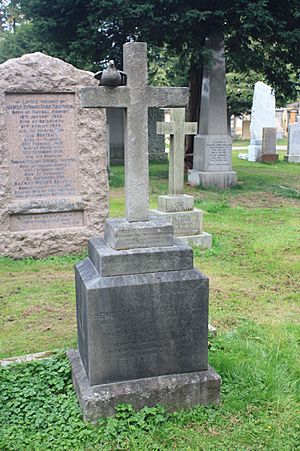Henry Darwin Rogers facts for kids
Quick facts for kids
Henry Darwin Rogers
|
|
|---|---|
 |
|
| Born | 1 August 1808 |
| Died | 26 May 1866 (aged 57) |
| Citizenship | United States |
| Scientific career | |
| Fields | geology |
| Institutions | Professor of Chemistry & Natural Philosophy, Dickinson College (1829) Surveyed geology of New Jersey and Pennsylvania< Professor of Geology, Philadelphia University; Professor of Natural History, Glasgow University (1857–66) |
| Signature | |
| Notes | |
|
Fellow of the Royal Society of Edinburgh (1856)
Fellow of the Royal Society of London (1858) |
|

Henry Darwin Rogers (born August 1, 1808 – died May 26, 1866) was an important American geologist. He was known for his detailed studies of rocks and the Earth's structure. His book, The Geology of Pennsylvania: A Government Survey (1858), was a very important book about American geology.
Contents
The Life of a Geologist
Henry Darwin Rogers was born in Philadelphia, Pennsylvania, on August 1, 1808. He was one of four sons of Patrick Kerr Rogers and Hannah Blythe Rogers. His parents were from Ireland and moved to the United States. His father, Patrick Rogers, had to leave Ireland because of his political beliefs. Henry was named after Erasmus Darwin, a famous poet his father admired.
In 1813, his family moved to Baltimore, Maryland. Henry went to public schools there. Later, in 1819, they moved to Williamsburg, Virginia. His father taught at the College of William & Mary, where Henry also studied for a short time. His father taught him most of what he knew.
Early Career and Education
After college, Henry worked with his brother William Barton Rogers at a school in Windsor, Maryland. When that school closed in 1828, he joined his brother teaching at the Maryland Institute.
At 21, Henry became a professor of chemistry and natural philosophy at Dickinson College in Pennsylvania. During his time there, he edited a science magazine called The Messenger of Useful Knowledge. His ideas about education, inspired by Johann Heinrich Pestalozzi, weren't popular at Dickinson, so he left in 1831.
His interest in education led him to meet social reformers Robert Owen and his son Robert Dale Owen in New York. They suggested he go to England. In 1831 or 1832, he traveled to England. There, with help from his brother William, he studied chemistry. He also learned about geology from famous scientists like Henry De la Beche.
Geological Surveys and Discoveries
Henry returned to Philadelphia in the summer of 1833. That winter, he gave lectures on geology at the Franklin Institute. After earning his Master's degree in 1834, he became a professor of geology and mineralogy at the University of Pennsylvania in 1835. He taught there until 1846. In 1835, he also became a member of the American Philosophical Society.
In 1835, he was chosen to study the geology and minerals of New Jersey. He published a report in 1836 and a full book, Description of the Geology of the State of New Jersey, in 1840.
In 1836, he led a big geology project for Pennsylvania. He worked actively in the field until 1841. In 1842, Henry and his brother William shared their findings about the Appalachian Mountains. William had also done a geological survey in Virginia.
Henry's research was detailed in his final report on Pennsylvania. This report also covered the geology of the United States and the coal fields of North America and Great Britain. He explained how coal fields were formed and how coal changes from bituminous to anthracite.
Later Life and Legacy
For the next ten years, Henry worked as an expert for various coal companies. In 1846, he moved to Boston. The Pennsylvania survey work started again in 1851 and continued until 1854. Six annual reports were published between 1836 and 1842. In 1855, he was asked to prepare a final report.
He moved to Edinburgh to finish this work, as it was less expensive there. He published The Geology of Pennsylvania, a Government Survey in 1858. This huge book had two volumes, 1682 pages, and many illustrations and maps.
In 1854, Henry married Elizabeth Stillman Lincoln. They had two children.
In 1857, he became a professor of Natural History and Geology at the University of Glasgow in Scotland. He also became the keeper of the Hunterian Museum. One of his later studies (1861) was about the parallel 'roads' (terraces) of Lochaber (Glen Roy). He believed these were formed by a huge flood.
Henry Darwin Rogers passed away in Glasgow in 1866. It seems he died from overwork, a weak body, and the climate in Glasgow. He was buried in Dean Cemetery in Edinburgh. Geologist John Young took his place at the University of Glasgow.
His Important Books and Papers
Henry Darwin Rogers wrote over 30 papers and reports. These included his annual and final reports for state surveys and reports on coal for mining companies.
- The Geology of Pennsylvania: A Government Survey (two volumes, 1858)

